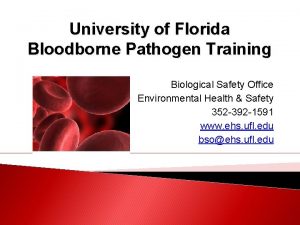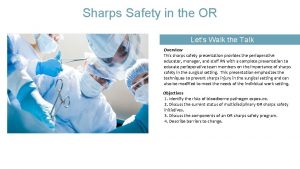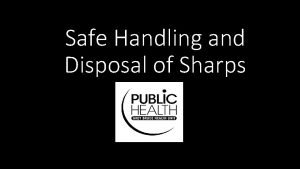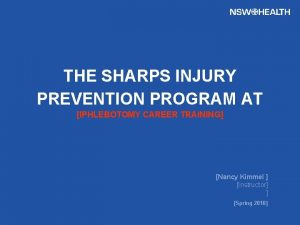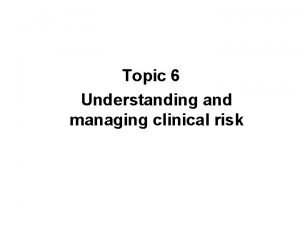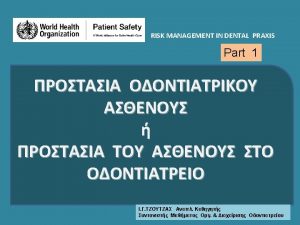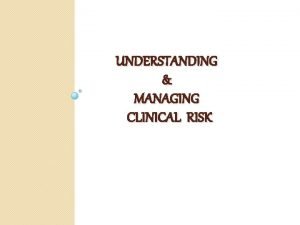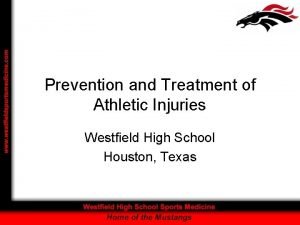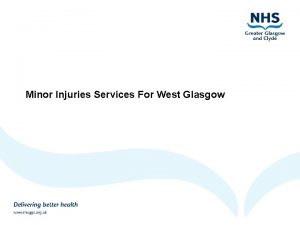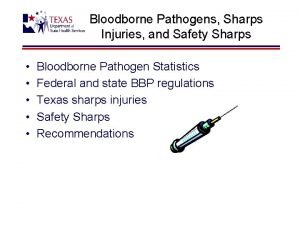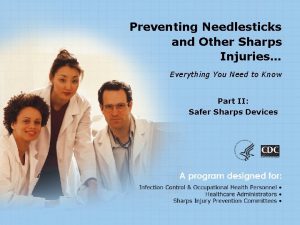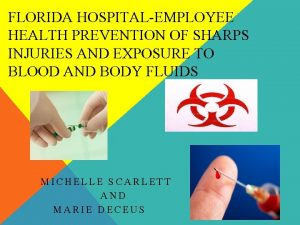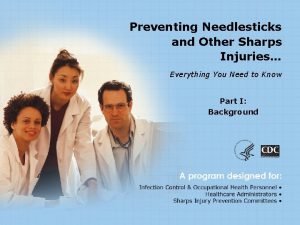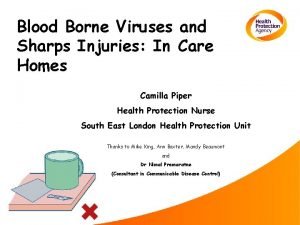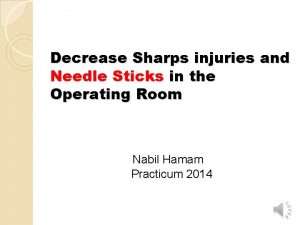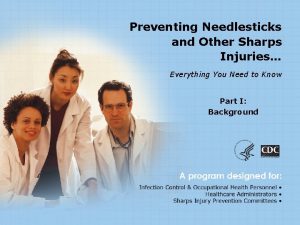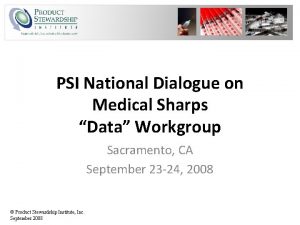Clinical Data Risk of Injuries Clinical Data Sharps




















- Slides: 20

Clinical Data – Risk of Injuries

Clinical Data – Sharps Injuries 100 k sharps injuries are reported each year in the UK [1] Up to 85% of sharps injuries in the UK go unreported [2], which means that the actual number of sharps injuries could be much higher. How many sharps injuries occur in your country? [1] Af. PP. Sharps Injuries in the Operating Theatre - A Practical Guide to Further Reducing the Risks: Purple Sugical 2015. 7. [2] Saia M, Hofmann F, Sharman J, et al. Needlestick injuries: incidence and cost in the United States, United Kingdom, Germany, France, Italy, and Spain. Biomedicine International 2010; 1(2): 419.

Clinical Data – Scalpel Blade Injuries 17% 8% Scalpel blade injuries are the second most common type of sharps injury in the OR, accounting for 17% of sharps injuries [1] Scalpel blade injuries account for 8% of all sharps injuries in hospitals [2] [1] Jagger J, Berguer R, Phillips EK, et al. Increase in Sharps Injuries in Surgical Settings Versus Nonsurgical Settings After Passage of National Needlestick Legislation. AORN Journal 2011; 93(3): 322 -30. doi: 10. 1016/j. aorn. 2011. 001 [2] Massachusetts. Departmentof. Public. Health. Overview of sharps injuries among hospital workers in Massachusetts sharps injury surveillance system, 2017.

Clinical Data – Scalpel Blade Injuries 12. 6 3. 2 Incidents per 100, 000 disposable syringes + loose needles used [1] Incidents per 100, 000 scalpel blades used [2] [1] Eisenstein, H. C. and D. A. Smith (1992). "Epidemiology of reported sharps injuries in a tertiary care hospital. " J Hosp Infect 20(4): 271 -80. [2] Based on the data from a tertiary hospital in Queensland, Australia (2012 -2014)

Clinical Data – Scalpel Blade Injuries Potential consequences UNCOMPLICATED – Surgery COMPLICATED – Blood-borne Infection Requires postexposure management Requires surgery and rehabilitation Requires ongoing/expensive treatment PSYCHOLOGICAL DISTRESS & ANXIETY A consequence of both uncomplicated and complicated sharps injuries

Clinical Data – BBI seroversions Serocoversion rate of BBIs due to sharps injury: HIV HCV HBV 1 in 300 1 in 3 [1] Doebbeling BN, Vaughn TE, Mc. Coy KD, et al. Percutaneous injury, blood exposure, and adherence to standard precautions: are hospital-based health care providers still at risk? Clinical Infectious Diseases 2003; 37(8): 1006 -13.

Clinical Data – Ampoule Injuries 1 in 3 nurses have hand injuries from ampoule cuts [1] 2033% 37% Of sharps injuries to nurses are caused by ampoules [2] Of nurses experience more than 1 ampoule injury in 6 months [3] [1] Smith DR, Choe M-A, Jeong JS, et al. Epidemiology of Needlestick and Sharps Injuries Among Professional Korean Nurses. Journal of Professional Nursing 2006; 22(6): 359 -66. doi: 10. 1016/j. profnurs. 2006. 10. 003 [2] Kahriman I, Polat S, Ede G, Kaptan D. Injury experiences and precautions taken by nurses working in pediatric wards towards penetrative/incisive tools. International Journal of Caring Sciences 2016; 9(2): 569 -578. [3] Lien CW & Liu PH. Systematic Innovation by User-centered Design: Case Study in Ampoule Opener Design. International Journal of Systematic Innovation 2018; 5(2): 45 -52.

Clinical Data – Ampoule Injuries 54% 6% Of sharps injuries to anaesthetists are caused by ampoules [1] Of anaesthetists have a hand injury caused by ampoules [2] [1] Pulnitiporn A, Chau-in W, Klanarong S, et al. The Thai Anesthesia Incidents Study (THAI Study) of anesthesia personnel hazard. Journal of the Medical Association of Thailand = Chotmaihet thangphaet 2005; 88 Suppl 7: S 141 -4. [published Online First: 2006/07/25] [2] Parker MRJ. The use of protective gloves, the incidence of ampoule injury and the prevalence of hand laceration amongst anaesthetic personnel. Anaesthesia 1995; 50(8): 726 -29.

Clinical Data – Ampoule Injuries Potential consequences UNCOMPLICATED – Surgery COMPLICATED – Blood-borne Infection Requires first aid and a break for the affected staff Requires surgery (ranging from stitches to nerve repair) and time off work Requires ongoing/expensive treatment PSYCHOLOGICAL DISTRESS & ANXIETY A consequence of both uncomplicated and complicated sharps injuries

Clinical Data – Ampoule Injuries Common medications causing ampoule injuries • • Edphedrine Fentanyl Metoprolol Propotol Phenergan Methergin Testosterone Bone cement Twitter user @AGraham 1208 post regarding recent causes of hand injuries

Clinical Data – Injury Costs

Cost Statistics – Scalpel Blade Injury Uncomplicated Injury Complicated Injury. Surgery Complicated Injury. Blood-borne Infection Post-exposure management for an uncomplicated sharps injury has been estimated to cost AUD 750 – 7, 500 [1] Surgery and rehabilitation for a complicated sharps injury has been estimated to cost AUD 1900 – 24, 000 [2] In the UK, the average ongoing treatment cost for each HIV case was estimated to be £ 22, 775 – £ 48, 000 (AUD 44, 650 – 94, 000) [1] O'Malley E, Scott R, Douglas, et al. Costs of Management of Occupational Exposures to Blood and Body Fluids. Infection Control and Hospital Epidemiology 2007; 28(7): 774 -82 [2] Jagger J, Hunt EH, Pearson RD. Estimated cost of needlestick injuries for six major needled devices. Infect Control Hosp Epidemiol 1990; 11(11): 584 -8. [3] Mandalia S, Mandalia R, Lo G, et al. Rising Population Cost for Treating People Living with HIV in the UK, 1997 -2013. PLOS ONE 2011; 5(12): e 15677.

Cost Statistics – Scalpel Blade Injury To the staff member: DISTRESS TO INDIVIDUAL & FAMILY LOSS OF INCOME COST OF TREATMENT Varying degrees of distress to depression. Post-traumatic stress disorder. Loss of individual income and productivity Out of pocket cost of treating the injury or infection

Cost Statistics – Scalpel Blade Injury To the patient: DELAYED OR CANCELLED PROCEDURES This has an adverse effect on the patient’s care ADDITIONAL BLOOD TESTS Blood tests to check for blood-borne infections IATROGENIC INFECTION Could lead to further complications for the patient

Cost Statistics – Scalpel Blade Injury To the healthcare facility: SOCIAL COSTS A sharps injury can lead to: Delayed service delivery, high staff turnover, poor functioning teams, and unplanned managerial time spent investigating incidents LEGAL ACTION WORKER’S COMPENSATION NON-COMPLIANCE ADMINISTRATIVE EXPENSES

Cost Statistics – Ampoule Injury Uncomplicated Injury The costs of an uncomplicated injury includes the first aid materials and time spent away from duties (5 -30 min) Complicated Injury. Surgery Complicated Injury. Blood-borne Infection Cases of ampoule injuries where stitches were required costed US $653. 45 [1]. Surgery and rehabilitation for a serious sharps injury has been estimated to cost AUD 1, 900 – 24, 000 [2] In the UK, the average ongoing treatment cost for each HIV case was estimated to be £ 22, 775 – £ 48, 000 (AUD 44, 650 – 94, 000) [3] [1] https: //allnurses. com/ouch-ampule-issues-anyone-else-t 143333/ [2] Jagger J, Hunt EH, Pearson RD. Estimated cost of needlestick injuries for six major needled devices. Infect Control Hosp Epidemiol 1990; 11(11): 584 -8. [3] Mandalia S, Mandalia R, Lo G, et al. Rising Population Cost for Treating People Living with HIV in the UK, 1997 -2013. PLOS ONE 2011; 5(12): e 15677. doi: 10. 1371/journal. pone. 0015677

Cost Statistics – Ampoule Injury To the staff member: LOSS OF INCOME DISTRESS INFECTION RISK Loss of individual income and productivity due to days off work Varying degrees of distress, including depression and anxiety. Ampoule injuries can increase infection susceptibility, especially to workers in highhazard areas (eg. OR)

Cost Statistics – Ampoule Injury To the healthcare facility: SOCIAL COSTS TREATMENT OF INJURY Delayed service delivery, high staff turnover, poor functioning teams, and unplanned managerial time spent investigating incidents Typically the healthcare facility must cover treatment costs for workplace injuries WASTED MEDICATION ADMINISTRATIVE EXPENSES WORKER’S COMPENSATION LEGAL ACTION

Cost Statistics– Flow on Benefits Multiple studies have shown that implementing staff safety measures have the following flow on effects: + + + + Increased quality of patient care and service Efficient patient flow Decreased absenteeism and overtime Improved communication and teamwork Higher work satisfaction and productivity A healthier, stable workforce Reduced lost time (caused by injuries) Sikorski, J. (2009). Connecting worker safety to patient safety: a new imperative for health-care leaders. Ivey Business Journal, 73(1), 8. Laschinger, Heather K. Spence, and Michael P. Leiter. "The impact of nursing work environments on patient safety outcomes: The mediating role of burnout engagement. " JONA: The Journal of Nursing Administration 36. 5 (2006): 259 -267.

Going Forward: The Total Solution SAFETY TOOLS Qlicksmart’s blade removers EVALUATE • Trial support • Value Analysis Calculator EDUCATE • Product Support • Training App • CE/CPD Sessions RESEARCH • Publications • Safety Innovations • Safety Score Audit
 Market risk assessment
Market risk assessment There were ____ reported sharps exposures at uf in 2020
There were ____ reported sharps exposures at uf in 2020 Solfege with sharps and flats
Solfege with sharps and flats Key signature rules
Key signature rules Sharps neutral zone
Sharps neutral zone Sharps disposal tweezers
Sharps disposal tweezers Chemical safety toolbox talk
Chemical safety toolbox talk Sharps injury prevention program
Sharps injury prevention program Understanding and managing clinical risk
Understanding and managing clinical risk Clinical risk management in dentistry
Clinical risk management in dentistry Managing clinical risk
Managing clinical risk Charlotte fox
Charlotte fox Unit 15:10 providing first aid for specific injuries
Unit 15:10 providing first aid for specific injuries How is katniss in peeta’s debt again?
How is katniss in peeta’s debt again? Sentinel injuries in infants are
Sentinel injuries in infants are Westfield sports injuries
Westfield sports injuries Victoria hospital glasgow minor injuries
Victoria hospital glasgow minor injuries Aims of first aid
Aims of first aid Chapter 28 head and spine injuries
Chapter 28 head and spine injuries Chapter 21 caring for head and spine injuries
Chapter 21 caring for head and spine injuries Chapter 17:11 providing first aid for sudden illness
Chapter 17:11 providing first aid for sudden illness

